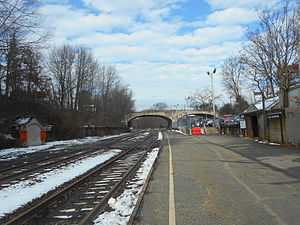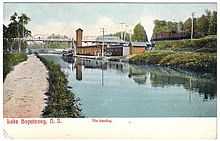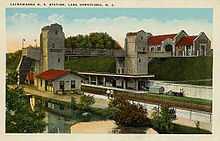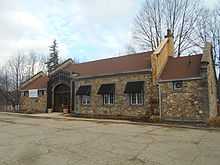Lake Hopatcong (NJT station)
Lake Hopatcong | |||||||||||||||||||||||||||||||||
|---|---|---|---|---|---|---|---|---|---|---|---|---|---|---|---|---|---|---|---|---|---|---|---|---|---|---|---|---|---|---|---|---|---|
 Lake Hopatcong station in December 2014, looking north toward Bridge 44.53. | |||||||||||||||||||||||||||||||||
| Location |
Landing Road (County Route 631) Lake Hopatcong, New Jersey | ||||||||||||||||||||||||||||||||
| Coordinates | 40°54′15″N 74°39′56″W / 40.90417°N 74.66556°WCoordinates: 40°54′15″N 74°39′56″W / 40.90417°N 74.66556°W | ||||||||||||||||||||||||||||||||
| Owned by | New Jersey Transit | ||||||||||||||||||||||||||||||||
| Line(s) |
(proposed) | ||||||||||||||||||||||||||||||||
| Platforms | 2 low-level side platforms | ||||||||||||||||||||||||||||||||
| Tracks | 2 | ||||||||||||||||||||||||||||||||
| Connections |
| ||||||||||||||||||||||||||||||||
| Construction | |||||||||||||||||||||||||||||||||
| Parking | 96 spaces | ||||||||||||||||||||||||||||||||
| Other information | |||||||||||||||||||||||||||||||||
| Fare zone | 19 | ||||||||||||||||||||||||||||||||
| History | |||||||||||||||||||||||||||||||||
| Rebuilt | 1911[1] | ||||||||||||||||||||||||||||||||
| Previous names | Hopatcong[2] | ||||||||||||||||||||||||||||||||
| Traffic | |||||||||||||||||||||||||||||||||
| Passengers (2012) | 114 (average weekday)[3] | ||||||||||||||||||||||||||||||||
| Services | |||||||||||||||||||||||||||||||||
| |||||||||||||||||||||||||||||||||
Lake Hopatcong Station is a New Jersey Transit station in the Landing section of Roxbury Township, New Jersey. It sits at the intersection of Landing Road and Lakeside Boulevard (County Route 631 and 602), about 600 feet southwest of the southern tip of Lake Hopatcong.
Today, the station consists of low-level asphalt platforms on either side of the tracks, with a shelter on the Hackettstown-bound platform and 96 free parking spaces. It is the simplest of at least three structures that have served rail passengers at the site for more than a century.
The station serves trains on the Morristown Line and the Montclair-Boonton Line, with service to Hoboken Terminal.
History
1880s DL&W station

The railroad tracks through Landing were first laid in 1854 by the Morris and Essex Railroad,[4] which was extending its line from Newark westward to Hackettstown. The right-of-way parallelled the three-decade-old Morris Canal past Lake Hopatcong, the canal's leading source of water. At 900 feet about sea level, it was the highest point on the canal, which flowed downhill to the Delaware River to the west and the Hudson River to the east, and on the M&E railroad.[5] But Landing itself, one of several hamlets that arose to serve the canal's boat crews and mule teams,[6] held no particular promise as a revenue stop, and so no station was built there for about 30 years.
That began to change in 1882, when the Central Railroad of New Jersey opened a station further up the lake and proved that there was money in direct passenger service to a promising vacation spot. Around 1886,[4] the first station in Landing was built by the Delaware, Lackawanna and Western Railroad, a CNJ rival that had taken over the M&E in 1868.[7] The small depot and platforms were sandwiched between the tracks and the canal, requiring most passengers to enter and depart via the steel, cable-stayed Landing Road Bridge.[8] This arrangement, however, did allow passengers to move easily between trains and the steamboats that would take them to lakeshore destinations.[6][7] A steamboat company, the Black Line, was founded that same year by "the same financial syndicate that owned the Lackawanna Railway and the Morris Canal."[4]
The station also prompted one of several manmade reshapings of Lake Hopatcong. In 1891,[4] when the new White Line steamboat company failed to secure the right to ply the canal, it dredged the swampy, non-navigable southern tip to create Landing Channel and erect a pier a block or so away from the tracks.[9]
1911 DL&W station

By 1906 or so, several factors led the DL&W to plan a new station. First, the area's summer tourist trade was growing as visitors flocked to the lake.[10] Second, the railroad was preparing to begin one of the most ambitious mainline construction projects in the world: the Lackawanna Cut-Off. This new, 28-mile route through the hills of northern New Jersey, designed to slice an hour off journeys to Scranton and points west and north, would begin at Port Morris Junction, less than a mile to the north.
So in 1910, as work proceeded on the Cut-Off, the DL&W began building a new station at Landing.[11] The main building was of native rough stone with cement trimming and a green glazed tile roof. Its oak interior had a ticket office, waiting room and baggage room. Because this depot sat up a hill on Landing Road, perhaps 20 feet higher than the tracks, the station complex also included long stairs down to the Hoboken-bound platform and elevated walkways with large elevators to transport passengers and baggage.[10]
The station itself cost $28,500[12] and the railroad was said to have spent $75,000 to build the accompanying structures.[10] The new station opened on May 28, 1911, six months before the first trains rolled on the Cut-Off.[13]
The elevated walkways rendered the old bridge completely redundant (its duties for vehicular traffic had already been assumed by a parallel bridge of stone built in 1907),[14][15] and it was eventually demolished.[16]
In the 1920s, the DL&W's station became the preeminent rail link to Lake Hopatcong, surpassing the CNJ's station at Nolan's Point. But change was afoot: In 1924, the canal was closed, its cargo business long since gone to railroads, and the steamboat dock removed.[4] Within five years, much of the canal was filled with new structures.
During its operation by the DL&W and its successor, the Erie Lackawanna, the Lake Hopatcong station provided transfers between trains using the Cut-Off and those headed to Phillipsburg, New Jersey, and Portland, Pennsylvania, via the Old Main line. In 1956, the DL&W merged with the Erie Railroad and the Lake Hopatcong station and tracks passed to the new Erie Lackawanna.
In 1976, the station and tracks passed to Conrail, which soon sold off the stone depot. The overpass structure was eventually declared unsafe,[17] and was brought down with dynamite in 1982.[10]
Post-railroad use of the 1911 depot

The stone station building, whose address became 125 Landing Road, served as a real estate office and a hardware store before being taken over by an interior design business whose proprietors restored the marble floor and other original features.[10] In 2012, it was occupied by a role-playing games store.
On November 6, 2014, the building was purchased by the Lake Hopatcong Foundation, which aims to use part of the structure as office and meeting space, and open the rest to the public as an environmental and cultural center.[18][19]
NJT station
Today, the New Jersey Transit station consists of little more than two low-level asphalt platforms, a small shelter on the westbound side, and a parking lot.[20] A shelter on the eastbound platform was demolished sometime after 2005.[5]
Future service
Since 2008, New Jersey Transit has relaid tracks and undertaken other preparations to restore service to a 7.3-mile (11.7 km) segment of the Lackawanna Cut-Off route between Port Morris Junction and a planned station at Andover in Sussex County. Passenger service is expected to begin in 2016. A further extension to Scranton has also been proposed.[21] Sen. Charles Schumer (D-NY) has proposed extending service to Binghamton, New York.[22]
References
- ↑ "Lackawanna's Big Cutoff Completed; New Double-Track Line Cost Millions, Moved Mountains, and Filled Valleys.". The New York Times. New York, New York. December 16, 1911. Retrieved September 9, 2010.
- ↑ Townsend Jr., Thomas Taber; Thomas Taber Townsend III (1980). The Delaware, Lackawanna & Western Railroad in the Twentieth Century - 1899-1960. Williamsport, Pennsylvania: Lycoming Printing Company. p. 742. ISBN 0960339825.
- ↑ "QUARTERLY RIDERSHIP TRENDS ANALYSIS". New Jersey Transit. Archived from the original (PDF) on December 27, 2012. Retrieved January 4, 2013.
- ↑ 4.0 4.1 4.2 4.3 4.4 Balston, Mottel (December 2002). "A HISTORY OF LANDING, MORRIS COUNTY, NEW JERSEY". LandingNewJersey.com. Retrieved October 27, 2012.
- ↑ 5.0 5.1 Savino, Robert E. (June 28, 2005). "Port Morris and Landing". The Lackawanna Cutoff - Then & Now. The Garden State Model Railway Club. Retrieved October 29, 2012.
- ↑ 6.0 6.1 Balston, Mottel. "The Morris Canal in Roxbury Township, Morris County, New Jersey". roxburynewjersey.com. Retrieved October 26, 2012.
- ↑ 7.0 7.1 Kane, Marty (25 February 2010). "THEN AND NOW: LANDING TRAIN STATION". Lake Hopatcong: Then and Now. Lake Hopatcong News & Review. Retrieved October 26, 2012.
- ↑ "Postcard of Lackawanna R.R. Station - Lake Hopatcong, New Jersey". Unknown photographer. Landing, New Jersey: Unknown. c. 1895. Retrieved 15 February 2010.
- ↑ Kane, Martin (1999). Hopatcong: A Century of Memories. Arcadia Publishing. p. 36. ISBN 9780752412580.
- ↑ 10.0 10.1 10.2 10.3 10.4 Kane, Marty. "PLACES ON LAKE HOPATCONG, PART 4: THE TRAIN STATION AT LANDING". Lake Hopatcong News & Reviews. Retrieved October 26, 2012.
- ↑ Rutan, Dave. "Lake Hopatcong". DL&W Old Main. Dave Rutan. Retrieved October 26, 2012.
- ↑ Taber III, Thomas Townsend; Taber, Thomas Townsend (1981). Delaware, Lackawanna & Western Railroad in the Nineteenth Century. Volume 3. Muncy, Pennsylvania: Thomas T. Taber III. ISBN 978-0-9603398-4-6.
- ↑ "Inspects Improvements Completed on D.L.&W". The Reading Eagle. December 21, 1911. p. 27. Retrieved 15 February 2010.
- ↑ Inventory, National Bridge (2008). "Structure Number: ++++++++1400073" 2008. Washington D.C.: United States Department of Transportation.
- ↑ "The Viaduct at Landing". Unknown photographer. Landing, New Jersey: Unknown. 1910. Retrieved 15 February 2010.
- ↑ "The New Lake Hopatcong Station". Unknown photographer. Landing, New Jersey: Unknown. 1911. Retrieved 15 February 2010.
- ↑ Yanosey, Robert J. (2007). Lackawanna Railroad Facilities (In Color). Volume 2: Dover to Scranton. Scotch Plains, New Jersey: Morning Sun Books Inc.
- ↑ "Lake Hopatcong Foundation Purchases Lake Hopatcong Train Station". Lake Hopatcong Foundation. November 7, 2014. Retrieved November 17, 2014.
- ↑ Redmond, Kimberly (November 17, 2014). "Lake Hopatcong train station will be restored, become non-profit's HQ (historic photos)". NJ Advance Media for NJ.com. Retrieved November 18, 2014.
- ↑ Adam Moss (2 January to 28 September 2010). "Lake Hopatcong (New Jersey Transit station)". Collections > The Railroads > Fallen Flag Railroads > Delaware, Lackawanna and Western Railroad · The Railroads > New Jersey Transit stations. Roadgeek Adam via Flickr. Retrieved October 27, 2012. Check date values in:
|date=(help) - ↑ "2007-2008 Annual Report" (PDF). New Jersey Association of Railroad Passengers. 2008. Retrieved May 17, 2010.
- ↑ "Poconos train to New York City is on track", "Morning Call", June 9, 2009 http://articles.mcall.com/2009-06-09/news/4387213_1_rail-line-rail-stations-new-york-s-penn-station
External links
| Wikimedia Commons has media related to Lake Hopatcong (NJT station). |
- Photo, ca. 1905, of the rail station and canal
- Map of the station area, ca. 1925-1942
- Erie-Lackawanna Railfan Site
- Station from Landing Road from Google Maps Street View